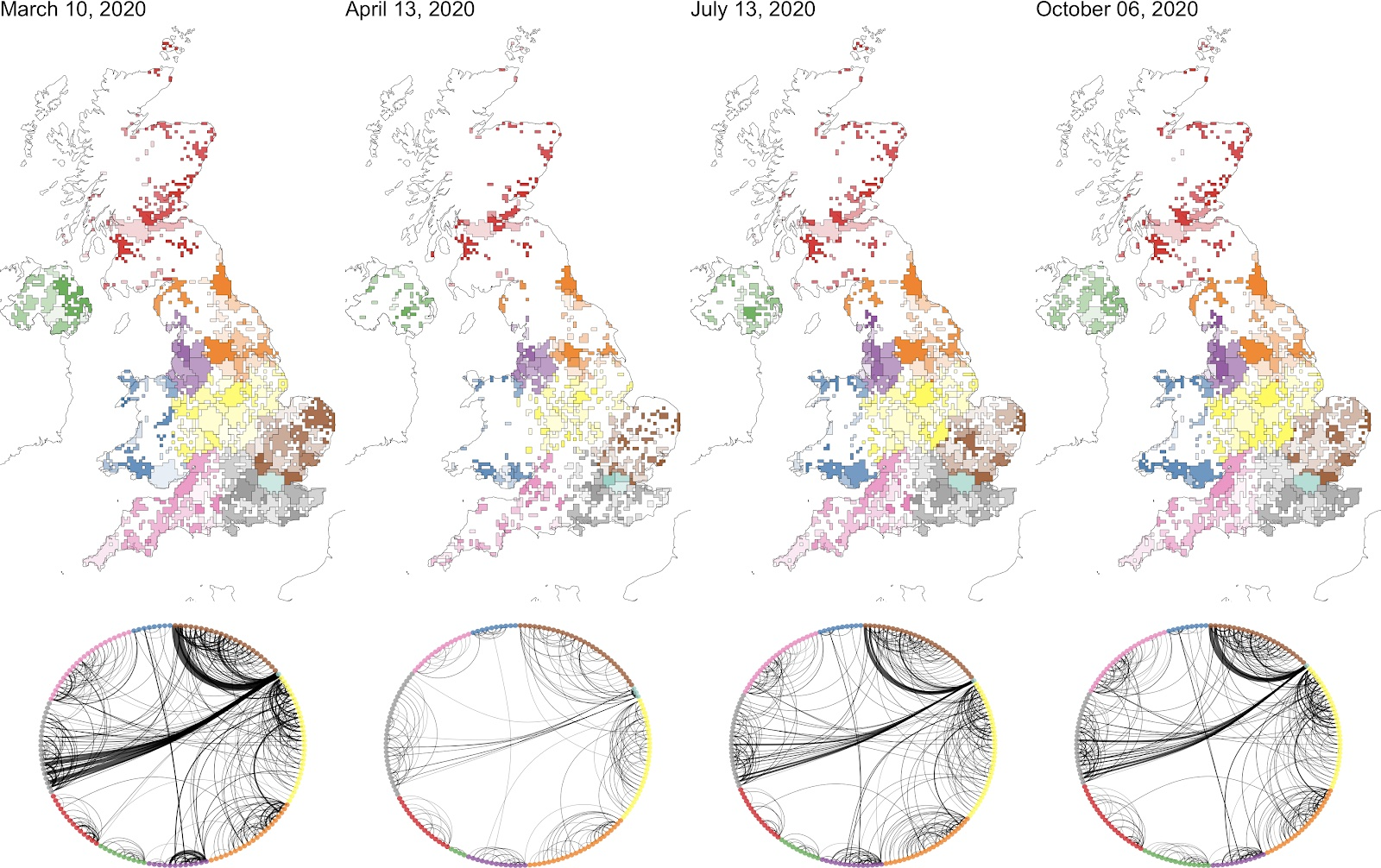Authors: Hamish Gibbs, Emily Nightingale, Yang Liu, James Cheshire, Leon Danon, Liam Smeeth, Carl A. B. Pearson, Chris Grundy, LSHTM CMMID COVID-19 Working Group, Adam J. Kucharski, Rosalind M. Eggo
Published: July, 2021 in PLOS Computational Biology

Abstract
On March 23 2020, the UK enacted an intensive, nationwide lockdown to mitigate transmission of COVID-19. As restrictions began to ease, more localized interventions were used to target resurgences in transmission. Understanding the spatial scale of networks of human interaction, and how these networks change over time, is critical to targeting interventions at the most at-risk areas without unnecessarily restricting areas at low risk of resurgence. We use detailed human mobility data aggregated from Facebook users to determine how the spatially-explicit network of movements changed before and during the lockdown period, in response to the easing of restrictions, and to the introduction of locally-targeted interventions. We also apply community detection techniques to the weighted, directed network of movements to identify geographically-explicit movement communities and measure the evolution of these community structures through time. We found that the mobility network became more sparse and the number of mobility communities decreased under the national lockdown, a change that disproportionately affected long distance connections central to the mobility network. We also found that the community structure of areas in which locally-targeted interventions were implemented following epidemic resurgence did not show reorganization of community structure but did show small decreases in indicators of travel outside of local areas. We propose that communities detected using Facebook or other mobility data be used to assess the impact of spatially-targeted restrictions and may inform policymakers about the spatial extent of human movement patterns in the UK. These data are available in near real-time, allowing quantification of changes in the distribution of the population across the UK, as well as changes in travel patterns to inform our understanding of the impact of geographically-targeted interventions.
Cite
@article{gibbs_detecting_2021,
title = {Detecting behavioural changes in human movement to inform the spatial scale of interventions against {COVID}-19},
volume = {17},
issn = {1553-7358},
url = {https://journals.plos.org/ploscompbiol/article?id=10.1371/journal.pcbi.1009162},
doi = {10.1371/journal.pcbi.1009162},
abstract = {On March 23 2020, the {UK} enacted an intensive, nationwide lockdown to mitigate transmission of {COVID}-19. As restrictions began to ease, more localized interventions were used to target resurgences in transmission. Understanding the spatial scale of networks of human interaction, and how these networks change over time, is critical to targeting interventions at the most at-risk areas without unnecessarily restricting areas at low risk of resurgence. We use detailed human mobility data aggregated from Facebook users to determine how the spatially-explicit network of movements changed before and during the lockdown period, in response to the easing of restrictions, and to the introduction of locally-targeted interventions. We also apply community detection techniques to the weighted, directed network of movements to identify geographically-explicit movement communities and measure the evolution of these community structures through time. We found that the mobility network became more sparse and the number of mobility communities decreased under the national lockdown, a change that disproportionately affected long distance connections central to the mobility network. We also found that the community structure of areas in which locally-targeted interventions were implemented following epidemic resurgence did not show reorganization of community structure but did show small decreases in indicators of travel outside of local areas. We propose that communities detected using Facebook or other mobility data be used to assess the impact of spatially-targeted restrictions and may inform policymakers about the spatial extent of human movement patterns in the {UK}. These data are available in near real-time, allowing quantification of changes in the distribution of the population across the {UK}, as well as changes in travel patterns to inform our understanding of the impact of geographically-targeted interventions.},
pages = {e1009162},
number = {7},
journaltitle = {{PLOS} Computational Biology},
shortjournal = {{PLOS} Computational Biology},
author = {Gibbs, Hamish and Nightingale, Emily and Liu, Yang and Cheshire, James and Danon, Leon and Smeeth, Liam and Pearson, Carl A. B. and Grundy, Chris and Group, {LSHTM} {CMMID} {COVID}-19 working and Kucharski, Adam J. and Eggo, Rosalind M.},
urldate = {2022-04-18},
date = {2021-07-12},
langid = {english},
note = {Publisher: Public Library of Science},
keywords = {Community structure, Centrality, {COVID} 19, Facebook, Pandemics, Population density, {SARS} {CoV} 2, Virus testing},
file = {Full Text PDF:/Users/hamishgibbs/Zotero/storage/NQV4R5DB/Gibbs et al. - 2021 - Detecting behavioural changes in human movement to.pdf:application/pdf;Snapshot:/Users/hamishgibbs/Zotero/storage/Y7TG7JGI/article.html:text/html},
}